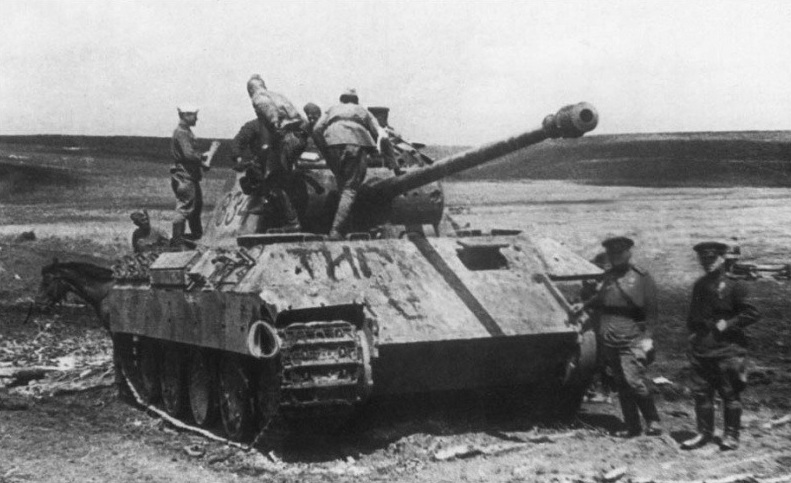
Posted on 03/18/2013 3:52:39 PM PDT by JerseyanExile
In the summer of 1944 the US Army forces in the European Theater of Operations (ETO) conducted a series of test-firings that are much quoted to this day by researchers and wargamers. These test-firings disputed the official line on the effectiveness of the guns and ammunition being provided by the Army's Department of Ordnance, and provided substantive feedback that changed some of the long-held assumptions and methods of Ordnance testing and specifications.
There were a total of four test shoots:
1) Shoeburyness, UK; 23 May, 1944: Demonstration firing to observe effectiveness of new US 76mm, 90mm and British 17pdr guns.
2) Balleroy, France; 10 July, 1944: Impromptu test of 17pdr APDS rounds against Panther tank
3) Isigny, France; 12 – 30 July, 1944: 1st US Army test of all available anti-armor weapons against Panther tank
4) Isigny, France; 20 – 21 August, 1944: 12 Army Group comparative test of US 76mm and British 17pdr ammunition against Panther tank, including new US HVAP ammunition
BACKGROUND: THE PANTHER CRISIS OF JULY, 1944
The US Army forces in the ETO went through a flurry of testing for one primary reason: The Panther tank.
The Panther tank came as a shock to US forces in the days after the Normandy invasion. Not that the Panther was unheard-of before D-Day. But somehow, the substantial information on the characteristics of the new German tank that were available to the US Army had not been correctly interpreted, and so its combat capabilities and its impact on operations had not been anticipated.

The Pz V Panther was first mentioned in the War Department publication “Tactical and Technical Trends” on 4 November, 1943. This report was based on information provided by the Soviets, as the Western allies had not yet met any Panthers in combat. The Soviets had captured or recovered several Panthers after the great armored battles of Kursk and their subsequent great advances across the Ukraine in the summer of 1943. While their reports to the Western allies had ample doses of propaganda on the effectiveness of Soviet weapons (in the hands of heroic Red Army soldiers, of course), they also provided very accurate technical information on the Panther, including comprehensive measures of armour thickness and slope, gun velocity and penetration, and automotive performance. The Soviets indicated that Panthers had better mobility than Tigers, but were notably easier to knock-out.
The US interpretation of the data was that it was an “intermediate” design, more like an M4 Sherman than prior German tanks:
It appears to be an intermediate type between the 22-ton PzKw 4 and the PzKw 6 (Tiger) tank. ... It approximates (corresponds roughly to) our General Sherman, a tank which evoked complimentary comment in the Nazi press.
The Soviets reported that Panthers were organized into separate battalions, as were Tiger tanks, rather than being integrated into the Panzer Regiments of the Panzer Divisions. This suggested to the US Army that it was not a mainstream design.
The next mention occurred in the January, 1944 issue of "Intelligence Bulletin". This publication repeated much of the same information, but now characterized the Panther as a heavy tank. This theme was repeated in the February, 1944 issue of the Journal of Recognition http://www.lonesentry.com/ferdinandpanther/index.html, which stated:
A new heavy tank in the German arsenal, the 45-ton PzKw Mark V series to bridge the gap between the 22-ton Mark IV and the 60-ton Mark VI, Tiger. This tank, which is called the Panther, appears to be a first-class vehicle, fast, well-armored and hard-hitting. It has the advantage of being swifter and more maneuverable than the Tiger but at the same time is easier to knock out because of lighter armor protection.
These reports included accurate measures of the Panther’s frontal armor. And they described the vehicle as being well-armoured. But they also suggested it was comparable to the M4, and noted that it was considered easier to knock-out than the Tiger. Also, they had come to characterize the Panther as a heavy tank … a tank that would be seen, like Tigers, only on rare occasions. The Panther was a Tiger that was easier to kill. No where was there any suggestion that a problem was brewing. No there was no expression of concern that the Panzer Divisions were now being re-equipped with a standard medium tank that was immune across its frontal arc to all of the anti-tank weapons then in service with US forces.
This alarming development would only be made glaringly obvious in combat in Normandy in the weeks following D-Day.
THE SHOEBURYNESS TESTS: 23 MAY, 1944
In the weeks before D-Day a demonstration test-firing was held for US Army commanders at Shoeburyness, in Essex, England. Ordnance had recently provided ETO with a rush shipment of 100 M4A1 tanks equipped with a new turret and the new M1A1 76mm gun. Ordnance had also developed a new tank gun from the M1 90mm AA gun – the M3 90mm gun, and since the spring of 1943 had been re-arming a total of 500 M10A1 tank destroyers with a new turret mounting this gun. In June of 1944 these re-armed tank destroyers would be standardized as the M36 Gun Motor Carriage
The firing test was organized to allow a selection of officers from ETO to observe and compare the firepower of these new and upcoming weapons. The 17pdr (76.2mm) AT gun, now coming into wide-spread use in the British forces of ETO, was also added to the test firing, as well as the then-current 75mm gun, which equipped both US M4 tanks (as 75mm gun M3) and British tanks (75mm QF Mk. V).
The test program consisted of a total of 15 shots, taken in three phases.
Phase 1: The 17pr, 76mm M1, and 90mm M1 guns were fired against test plates 120mm thick, at a slope of 30º, at ranges of 800, 400, and 100 yards, to determine their comparative effectiveness.
Phase 2: The 17pdr, 76mm, and 90mm guns were fired against test plates 100mm thick, at a slope of 30º, which was backed by another vertical plate 100mm thick, at a range of 500 yards, to determine the behind-armor effects of the rounds.
Phase 3: The 75mm Mk V gun, using American M61 APC ammunition, was fired against test plates 20mm thick, placed 6 inches in front of test plates 50mm thick, both at a slope of 30º, to test the effectiveness of the round against spaced armor. In this test half of the rounds were fired either with their explosive filler (referred to as “shell”), or with the filler and the base-detonating fuse removed (referred to as “shot”). This would be a test to validate the capability of the 75mm against a MkIV equipped with Vorpanzer.
The tests were conducted against US test-plate, which was 240 BHN (Brinnel Hardness) homogenous rolled steel. On the original report, the reference to homogenous plate is crossed-out, and “face-hardened” is hand-written in for the 50mm plate of the Phase 3 tests. This is presumed to refer to the actual test plates, but it could instead reflect the interests of some reviewer, as Germans used face-hardened armour.
The results of the tests are as follows:
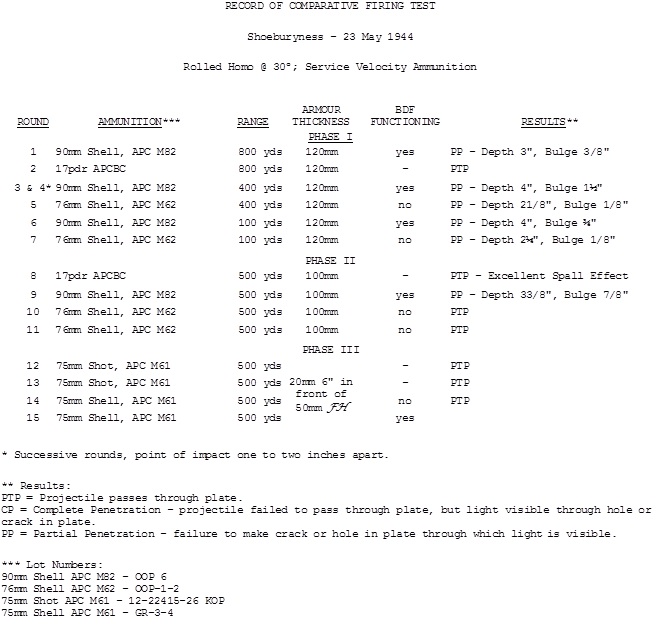
The tests showed the superior penetration of the British 17pdr. They also indicated a tendency for US shells to explode before passing through the target armour (a “yes” in the column titled BDF Functioning indicates that the fusing caused the shell to detonate, an event which is highly correlated with failure of the round to pass through the plate).
The tests led to the stated conclusion that shot held no particular advantages over shell, but that the base-detonated fuses of US AP rounds had a tendency to detonate the rounds prematurely. A memorandum was sent from ETO to Ordnance, under Eisenhower’s signature, calling for an immediate remedy to the fusing, or if that wasn’t possible calling for all further AP ammunition to ETO to be provided un-fused with an inert filler.
Perhaps more important was what was left unstated. First there was evident concern to ensure that the 75mm gun on Sherman could handle the Pz IV, a clear indication of what German tanks the Army was expecting to face. Second was that the tests gave evidence (and confidence) that the new 76mm gun available on the Sherman, as well as the 3-inch gun on the M10 (which fired the same projectiles and was a ballistic match to the 76mm M1 gun), would penetrate 100mm of German armor at 30º at reasonable combat ranges, allowing these vehicles to handle the occasional Tiger (100mm hull front) or Panther (80mm at 55º), should they appear.
US Army commanders were so confident in their guns, and so complacent about the risks posed by the Panzers, that there was no call for 90mm-armed vehicles, no recommendation for further up-gunning beyond the 76mm gun, and no call for improved penetration for the existing ammunition (beyond fixing the fuses). British offers of the 17pr were politely declined as unnecessary. So complacent were the US commanders, in fact, that the 100 up-gunned Shermans with 76mm guns that had been rushed to the ETO were turned down by unit commanders as being an un-necessary complication to their logistics and training, and were left behind in the UK on D-Day.
That attitude changed quickly after 6 June.
THE BALLEROY TEST: 10 JULY, 1944
Once armoured units got off of the beaches of Normandy and into the bocage country, they were confronted by the reality of the Panzers. Attacking up narrow roads confined by dense raised hedgerows, or facing their enemies across the hedge-lined farm fields, Allied tankers were stuck with little room to maneuver, and faced many occasions where head-on gunfire exchanges was their only option. In these cases Allied armor, and US tank formations in particular, seemed to come off poorly. Tigers were not quite as rare as expected. More importantly Panthers were not rare at all.
The 75mm gun on the M4 was woefully inadequate to facing either a Tiger or a Panther frontally. So by late June the cry went out for the M4(76)s in the UK to be shipped to France for issue to the medium battalions.
Unfortunately, the new up-gunned Shermans did little to redress the problem. Despite what was shown on Ordnance Department tables, and despite what the tests in the UK had shown, reports from US tank units in the field indicated that the new 76mm guns were no better than the old 75mm guns when it came to facing Panthers and Tigers. Something was wrong.
The experiences of the British, however, seemed to justify their confidence in the 17pdr. Their up-gunned Sherman “Firefly” tanks were indeed apparently capable of handling Tigers and Panthers.
To demonstrate this, an impromptu test firing was conducted at Balleroy, in Normandy, against a captured Panther tank. US First Army was provided with a British 17pdr, with new APDS (discarding sabot) ammunition. There was no formal report or minutes written from this test firing. However photos of the results were routed through US field commanders in Normandy. The results were summarized in a subsequent report:
… in firing conducted by First U.S. Army at Balleroy on 10 July 44, 5 rounds were fired at the front plate of a Panther tank at 700 yards. Examination of pictures of this firing indicates that the first round struck the mantlet, the second between the track and the nose plate, the third at the junction of the nose and glacis and penetrated. The fourth and fifth were fair hits on the glacis and both penetrated.
In contrast to this, field reports indicated that the 76mm gun was failing to penetrate the Panther’s glacis under any circumstances.
A sense of betrayal quickly developed. US tankers were surprised by the poor performance of the US 75mm gun against the panzers, and even more surprised when the new “hot” 76mm gun did no better.
What was not clearly known at the time was that there was a flaw in the nature of US testing. US Army Ordnance had full belief that ductile armour made safer protection. What this means is that US tanks were made of relatively soft and flexible armour. 240 BHN was the standard for US rolled homogenous plate, while US cast armour, such as found on the M4’s turret and the hull of the M4A1, was often as soft as 210 or 220 BHN. This compares with German armor which ranged from about 260 BHN for their thickest plates, to over 340 BHN for thin armor. The 50mm on the front of the MkIV was face-hardened to 588BHN with 365 homogenous behind it, making it far tougher than the test plate from Shoeburyness.
The benefits of softer more ductile plate are two-fold. First, it is easier to work with in production. Second, when struck the armor tends to bend and flow rather than crack or shatter, and when a round does penetrate there will typically be less spalling and fragmentation carried into the interior of the tank with the projectile. The downside is that the armour will be less resistant to penetration in the first place.
Now, tankers will generally take exception to the notion that a government engineer somewhere is willing to see holes punched in their steeds so long as they don’t get too many “friendly” fragments coming into their crowded office space along with the several pounds of white hot metal travelling at thousands of feet per second that the enemy kindly provides with the new ventilation. Ease of production is even lower on the crewman's priority list. Indeed, the overwhelming view is more that the armour is generally there to keep things out, not to let them in with minimal added disturbance.
In fairness it is worth noting that Ordnance’s concept of minimizing the after-affects of perforation may well have achieved its stated goals, as was demonstrated by the relatively low casualty rates among crews in US tanks which were destroyed in action:
During the period of 6 June through 30 November, 1944, the US First Army suffered a total of 506 tanks knocked-out in combat (counting both those written-off and reparable). Of these 506 cases, in 104 cases there were no casualties associated with the loss of the tank. In 50 cases the casualties were not recorded. Out of the remaining 352 cases there were 129 KIA (0.37 per tank) and 280 WIA (0.80 per tank), for a total average rate of 1.16 casualty per tank lost in combat.
How much this is due to design aspects such as ammunition storage or escape hatches, and how much is due to the ductility of the armor, can not be assessed. And how many more tanks were destroyed in action in the first place, because of their softer armor, is up for anyone’s guess. There is certainly an argument to be said that a Panther's long 7.5cm would go through an M4 even if it had harder armour, so perhaps the engineers in hindsight made the better call, but we could go into what-ifs for ever. I digress.
What can be observed, however, is that US Ordnance testing was done on US Ordnance armour plates. The Germans, being the evil underhanded fiends that they were, did not use US Ordnance plates on their Panther and Tiger tanks. They used German plates, which were notably harder. So despite Ordnance test results and assurances, the weapons available to the US Army forces in Normandy could not reliably penetrate the frontal armor of the heavier German panzers.
The Panther was becoming a real problem for US commanders. Yet it seemed that the British had working solutions.
THE US FIRST ARMY TEST AT ISIGNY: 12-30 JULY, 1944
The US First Army convened a board of officers to conduct test firings at a range prepared at Isigny-sur-Mer in Normandy, in order to provide workable data on US weapons performance against Panther and Tiger tanks. This became known as US Army Test No. 2. It was the second time a board of officers was convened in ETO to perform a course of test firings, after the Shoeburyness test. The label is often confusing, as Isigny Test No. 2 is in reality the first Isigny test. There was a second test firing done at Isigny a month later that was not labeled as Test No. 2 (Keep that in mind if you ever go searching for the historical documents!).
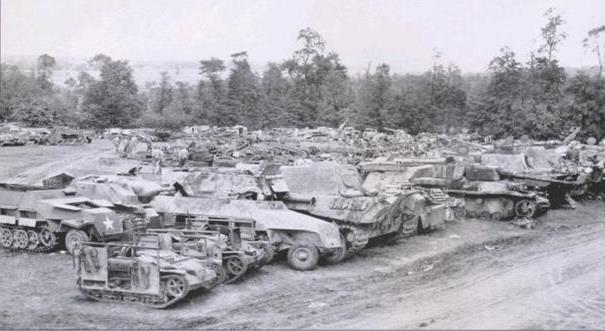
A view of the Isigny depot in Normandy, where captured German armor was collected. The picture shows several German-modified French vehicles along with StuGs, Panthers and Pz IVs.
The purpose of the board, as stated in their report of proceedings, dated 30 July, was:
To conduct tests to determine the effectiveness of tank and anti-tank weapons in First U.S. Army, against the German Mk V "Panther" and Mk VI "Tiger" tanks.
The methodology of their testing was as follows:
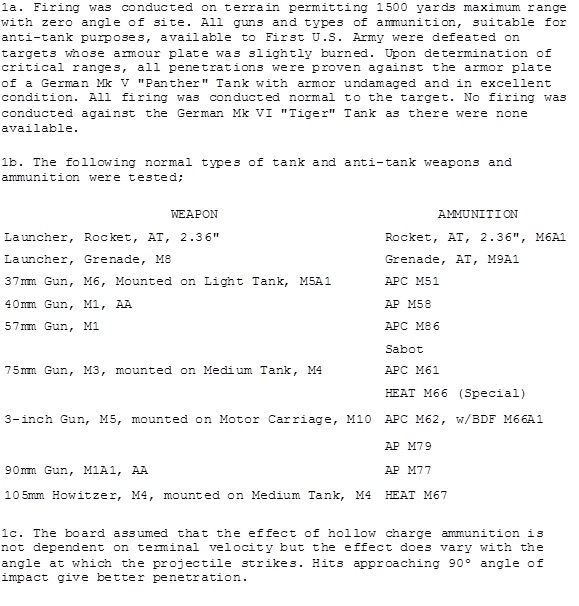
The Isigny test No. 2 was a thorough and well-constructed test, making use of the resources available (a few Panthers with varying degrees of battle-damage) to gather real-word data. The report of proceedings provided credible documentation for its results. An appendix was attached providing photographs and information on the particulars of the various rounds fired.
It is noteworthy that while the board was convened to test US weapons against both the Panther and the Tiger, the Tiger proved, as ever, to be a rare and elusive cat. Given the pressures for real information by the forces in the field, the tests went forward with only Panthers as targets.
Let’s take a look at what the board determined about tank and anti-tank rounds.
First, the 37mm gun:
3) 37mm Gun, M6, Mounted on Light Tank, M5A1 APC, M51 will penetrate the sides and rear of the 'Panther' Tank at 600 yards.
Un-ambiguous and to-the-point. For the 57mm AT gun the story gets a bit more complicated:
5) 57mm Gun, M1 a) APC, M86 will penetrate the sides and rear of the 'Panther' Tank at 1500 yards.
b) Sabot fails to penetrate front glacis slope plate and gun shield at 200 yards. Due to difficulty experienced in obtaining hits no conclusion as to the effectiveness of this ammunition was reached.
Finding 5a is clear. But 5b is a little more complicated. The conclusion indicates that APDS would not penetrate the Panther frontally at minimal range. But the board could not determine the range at which it would penetrate the sides because they quite simply couldn’t hit the target. The conclusion is stated in neutral terms, but represents a growing point of contention. Despite British praises of their sabot rounds, the US Army could not abide by the inaccuracy that they saw with the new British rounds.
Onwards:
6) 75mm Gun, M3, mounted on Medium Tank, M4 a) APC M61 will penetrate the sides and rear of the 'Panther' Tank up to 1500 yards. APC M61 at 200 yards will not penetrate the front armor of the 'Panther' Tank.
b) HEAT M66 (Special) will not penetrate the front glacis slope plate at 500 yards (see assumption made in paragraph 1c).
Seeing that neither the APC shell nor the HEAT round would provide a solution for frontal engagements, the board went on to test the field-expedient alternatives of white-phosphorous (used for smoke screens) and HE rounds:
In addition to testing the normal types of tank and anti-tank weapons and ammunition, additional types were tested with the following results:
A) 75mm Gun, M3, mounted on Medium Tank, M4 WP M64 - Three rounds were fired at 500 yards for the purpose of obtaining an incendiary or blinding effect. The results were unsatisfactory.
B) 75mm Gun, M3, mounted on Medium Tank, M4 HE M48 w/fz T105 - Three rounds were fired at the front glacis slope plate at 500 yards to determine its armor penetrative characteristics. The rounds failed to penetrate, ricochetting from the plate and bursting in the air.
It's worth noting that there was still a psychological effect: Even if the incendiary effect of WP was such that it wouldn't cause the target vehicle to burn, the crewmen inside the vehicle had little way of knowing that: They'd just see smoke out the vision blocks. As a result, WP could knock out German armour by the simple expedient of getting the crews to abandon the tank. You wouldn't want to rely on this as a default reaction, of course, but some hope is better than none at all.
Ordnance had developed both AP shot and AP shell rounds for the 3-inch and 90mm guns. US M62 AP shell rounds were capped, and so are identified as APC in the table, while the un-capped M79 solid shot rounds are listed only as AP. Even though the numerical labels may indicate otherwise, the M79 AP shot rounds were in fact the earlier rounds to be issued, and were generally replaced by the M62 APC shell rounds after the Tunisian campaign..
The most significant information from the testing was the failures of the 3-inch (and hence also 76mm) rounds:
7) 3-inch Gun, M5, mounted on Motor Carriage, M10 a) APC M62, w/BDF M66A1 will not penetrate front glacis slope plate at 200 yards. Will penetrate gun mantlet at 200 yards and penetrate sides and rear of the 'Panther' Tank up to 1500 yards.
b) AP M79 will not penetrate the front slope plate or the mantlet at 200 yards. It holds no advantage over APC M62 ammunition w/BDF M66A1.
The US Army had been convinced that its 3-inch and 76mm guns were the right solution to the German Panzers. So disillusioning was this test result that it prompted comment directly from Eisenhower himself, in his oft-quoted statement: Ordnance told me this 76mm would take care of anything the Germans had. Now I find you can’t knock out a damn thing with it.
Better news was found regarding the 90mm gun:
8) 90mm Gun, M1A1, AA AP M77 will penetrate front glacis slope plate up to 600 yards, the gun mantlet up to 1,000 yards and the turret up to 1,500 yards.
This gun also had the effects of its HE round tested, demonstrating the processes by which non-penetrating hits by heavy HE could damage a tank’s armor:
C) 90mm Gun, M1A1, AA HE M71, w/fz M48 - One round was fired at 1500 yards as a ranging shot. No perceptible effect was obtained beyond cracking the welds between the glacis and nose plate and the glacis and side plate for a distance of approximately 12 inches. The corner of the glacis slope plate appeared to have a slight depression as a result of this round.
And finally, the 105mm howitzer with its HEAT round seemed to have enough penetrative performance, if it could ever score a hit:
9) 105mm Howitzer, M4, mounted on Medium Tank, M4
HEAT M67 will penetrate front glacis slope plate and gun mantlet at 500 yards (see assumption made in paragraph 1c).
The board concluded with a set of recommendations for Ordnance:
In view of the above findings the board recommends:
1. That steps be taken by the Ordnance Department to develop armor piercing ammunition of materially higher muzzle velocity and penetrative characteristics for the 3-inch, 76mm, and 90mm Guns, accepting, if necessary, a gun tube life as low as 200 rounds.
2. That upon availability of 90mm APC M82 ammunition in this theater, tests be conducted to determine the effectiveness of this ammunition against the 'Panther' Tank.
3. That consideration be given by the Ordnance Department to the development of a liquid filled incendiary shell capable of igniting the target adjacent to the point of impact, for the 75mm Gun and the 105mm and 155mm Howitzers.
The first recommendation is the key issue. The troops wanted better AP performance from their guns. The British had a 76.2mm gun which could penetrate a Panther, but the US didn’t. The reason was that the British gun used more powder for a higher chamber pressure, and so achieved a higher muzzle velocity. US Army Ordnance had rejected such an approach because high chamber pressures wore out gun barrels. Ordnance was determined to stick to one of the basic tenants developed during the economy-minded inter-war period – that a gun barrel had to have a service life of 2,000 rounds. The commanders in ETO felt that a 90% reduction in barrel-life was justified if it meant guns that could knock-out Panthers.
The Isigny Test No.2 generated multiple cables of correspondence between ETO and the US.
The underlying issue was less bureaucratic intransigence on the part of Ordnance, and more a matter of in-experience. Ordnance continuously developed new anti-tank weapons and munitions, and submitted them for consideration to their “customers”: the Army Ground Forces (AGF), the Armored Command, and the Tank Destroyer Command. These three entities had reports from the French, British, and Russian forces, but only limited direct US Army combat experience (in the Mediterranean region) to call upon. Additionally, with the dramatic expansion of the US Army in 1941-43 the personnel in charge changed multiple times per year. As a result, the feedback was inconsistent and often contradictory.
But now that the troops were back in combat against the Panzers, feedback was flooding in. And it was not good.
Ordnance had prepared for heavier German armor. They had, on their own initiative, developed the 76mm gun, the up-gunned M4, the 90mm gun and the up-gunned tank destroyer (M36). AGF and the Armored and Tank Destroyer Commands had neither requested nor encouraged any of these. But Ordnance had also developed another item that nobody seemed interested in … tungsten cored sub-caliber penetrators for their anti-tank guns. In US Army parlance: HVAP (High-Velocity Armor Piercing). As an aside, the pre-planned up-gunning of M4 should be taken as a further nail in the coffin of the perception that American tanks were not designed to be able to kill enemy tanks.
When the Panther crisis arose in Normandy, and the first Isigny tests indicated that the 3-inch and 76mm guns were incapable of penetrating Panthers frontally at normal combat ranges, Ordnance shipped 1,000 of their experimental T4 76mm HVAP rounds to ETO by air for evaluation. Another round of testing was in order.
12th ARMY GROUP TESTS AT ISIGNY: 20-21 AUGUST, 1944
The second set of tests conducted at Isigny were organized under order of the 12th US Army Group, parent of the US First Army. The matter had escalated.
The testing board was convened on 19 August at the same firing range at Isigny. This set of tests were specifically against Panthers, and were to compare the US 76mm gun and new HVAP ammunition to the British 17pdr. The tests used standard ammunition for both guns, and then explored some board-suggested experiments on alternative loadings.
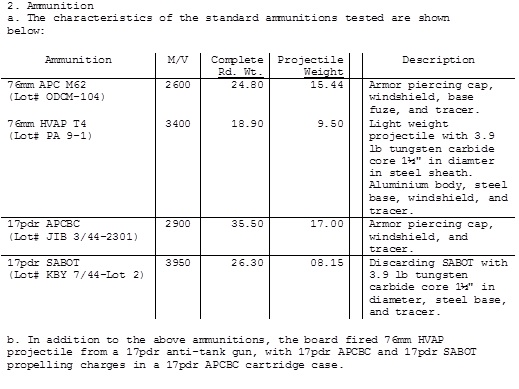
The test firings were conducted on 20 and 21 August. A preliminary report was issued on 22 August, and a final report on 30 August.
Great care was taken to describe the target tanks and the angles presented by the location of the tanks vs. the guns:
3. Nature of Test
a.The above ammunitions were fired at the front plate of three Panther tanks. The general characteristics of the frontal armor are: glacis plate 85mm (3.35") at 55º and nose nlate 65mm (2.56") at 55º. Using US Armor basis curve, the vertical equivalent of the glacis plate is 187mm (7.36") and of the nose plate 139mm (5.47"). Due to the inclination of the ground, the angle with the vertical of the glacis plates on the tanks used in this test were 57º 34', 57º 05' and 56º 53'. The nose plate on one of the tanks tested measured 66.67mm (2 5/8")
This appears to be the first time that an examination of the Panther includes an assessment of the effective thickness of the glacis plate – note the reference to the “armor basis curve”, which suggests that the Panther’s 85mm of frontal armuor at 55º was effectively the same as 187mm of vertical plate, meaning that the Panther’s frontal protection was far in excess of the Tiger’s, and well beyond the penetration of the standard projectiles for the US 3-inch and 76mm guns.
Of note was that the levels of protection provided by the German armor differed from one tank to the next:
b. Wide variation was found in the quality of glacis plate on the three tanks. Tank No.2 (hereafter referred to as the "best plate") sustained 30 hits at ranges from 600 to 200 yards without cracking. Tanks Nos. 1 and 3 (hereafter referred ti as "average plate") cracked after relatively few hits. All conclusions are, therefore, base solely on the relative performance of rounds fired at a single plate. Comparisons are not made between rounds fired at different plates.
This is the first indication that German armor production was producing plates of un-even quality. Later Soviet reports also indicated variance in tests against individual Panther tanks.
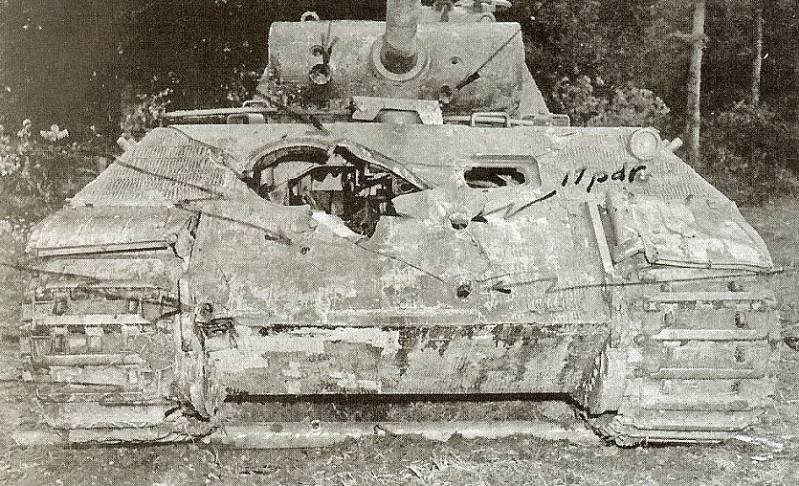 A picture included as an attachment with the report shows one of the 3 Panthers used in the August, 1944 Isigny tests. Note how the plate has shattered around the hull MG bulge – a catastrophic failure indicative of the “edge effect”. This picture demonstrates the difficulty of interpreting firing tests when the shots fired are many, and the targets are few.
A picture included as an attachment with the report shows one of the 3 Panthers used in the August, 1944 Isigny tests. Note how the plate has shattered around the hull MG bulge – a catastrophic failure indicative of the “edge effect”. This picture demonstrates the difficulty of interpreting firing tests when the shots fired are many, and the targets are few.
Whether these were truly due to uneven quality of the armor (the Germans were adjusting the alloy content of their plates to compensate for shortages of some metals), or were due to the degradation of plates that were struck by multiple projectiles in close proximity is hard to asses. The shock waves that propagate through metal from powerful blows can weaken it, even if there is no visible damage or penetration. This is particularly true around the edges of the plate, where the shock waves can compound as they reflect back much like ripples at the edge of a pond of water. Modern tank design focuses on un-interrupted plates with no through-holes (no direct vision ports or hull machine guns) in order to minimize the number of edges in the plate. But the phenomenon of such “edge effects” was not well understood in 1944.
The first test firing at Isigny had indicated some problems with the accuracy of the APDS ammunition for the 57mm AT gun. Evidently this led to some finger-pointing among the allies, as the Americans claimed the rounds were not accurate enough to use, while the British claimed the Americans were simply un-schooled in their use (or, more likely, that they just couldn't shoot straight).
Efforts were made to control for this variable in the second tests at Isigny:
f. The 17pr guns were fired by two superior British enlisted gunners. The 76mm gun was fired by two officers with considerable test firing experience.
Even with trained British gunners, the accuracy of the APDS rounds for the 17pr were strongly called into question by the results.
In the test results of the report, the first issue addressed is accuracy, before the question of penetration is even considered:
b. Accuracy
(1) A tabulation does not present a true picture of the comparative accuracy of the various ammunitions. With all the standard roundfs, except the 17pr sabot, the accuracy was such as to warrant attempting to hit specific parts of the front plates. In general this was successful, but some rounds fired at the lower glacis struck the upper nose, and vice versa. In addition, it was not possible to position all the tanks so that the nose was not, at least partially, hidden by the ground line. Therefore it is felt that a better measure of accuracy can be obtained by considering the nose and glacis as one target.
(2) On this basis all twenty-two (22) rounds of 76mm HVAP, T4, and all twenty-three (23) rounds of 17pr APCBC hit the target. Only one (1) of eight (8) rounds of 76mm APC, M62, which fell short attempting to hit the nose, failed to hit the target. Forty-two (42) rounds of 17pr sabot were fired, and only 57% (24 rounds) were hits. More rounds of 76mm APC, M62 were not fired since its accuracy had been well established in previous firing in the US by two members of the board.
Anti-tank ammunition which was not accurate enough to reliably hit a tank-sized target at ranges of 200 to 600 yards in a range-test with unlimited time, and with no stresses of combat, was not considered acceptable to the US Army.
A British officer who was present compared these results with the results from the earlier Balleroy test firing, and sought to explain the poor accuracy of the APDS rounds seen at Isigny:
The conflict between these results and those obtained by the board is explained by Col. A. G. Cole, Deputy Director of Artillery, Ministry of Supply. Col. Cole witnessed part of the test and states that the ammunition lot furnished the board had not been proof fired. He further states that, in his opinion, the lot is of a sub-standard manufacture and if proof fired would not have been accepted.
Based on this input, the report from the August tests includes this comment in the findings:
The board invites attention to the fact that its findings and conclusions apply only to the ammunition furnished it and may not apply to good quality 17pr sabot.
That was nice of them..
Going back to the available information on the Balleroy test, though, it does not seem obvious that the APDS fired in that test were substantially more accurate than at Isigny. At 700 yards, two “fair hits” on the glacis were obtained out of five rounds fired. Another round struck the joint of the glacis and the lower nose, which by the Isigny standard would have been considered a fair hit too. If the gunners in that test had in fact been aiming explicitly at the glacis for all five shots (rather than at the turret face or the tracks), that suggests accuracy that is reasonably consistent between the two tests.
To put more perspective on accuracy of British APDS at that time, I would note that the British Army’s own test results, obtained by two 17pr-armed Sherman Firefly tanks in September of 1944, were no better. These results and comments were published in Warrant Office Reports WO 291/1263 and WO 165/135 dated 22 September:
400 yds APC hit 90.5% APDS hit 56.6%
600 yds APC hit 73.0% APDS hit 34.2%
800 yds APC hit 57.3% APDS hit 21.9%
1000 yds APC hit 45.3% APDS hit 14.9%
1500 yds APC hit 25.4% APDS hit 7.1%
These tests were conducted against standard range targets which, for the British Army gunnery the time would have been 6' by 6' – so not quite as large as the frontal aspect of a Panther (which is closer in size to the broad side of a barn). Still, the results show a rather disappointing accuracy for the APDS rounds.
The same WO reports include these comments as guidelines for aiming:
... useful range of APC ammunition was 900 yards while that of APDS was only 450 yards.
... there is no use in attempting to pin-point vital zones in targets at ranges over about 200-300 yards
So despite Col. Cole’s protestations, and the polite statement of findings by the test boards of both Isigny tests, it does not appear that the accuracy of APDS achieved in US Army testing was so far out of line. Rather, it seems to be reasonably consistent with other tests.
In fact only the British embraced APDS with enthusiasm in this timeframe. The US, Soviet and German armies stuck with composite (non-discarding) sub-caliber rounds throughout the war, and the US and Soviet armies continued on through the 1950s, not adopting discarding sabot rounds until the accuracy issues had be unquestionably resolved in the 1960s.
The full findings and conclusions of the board of the August Isigny tests were:
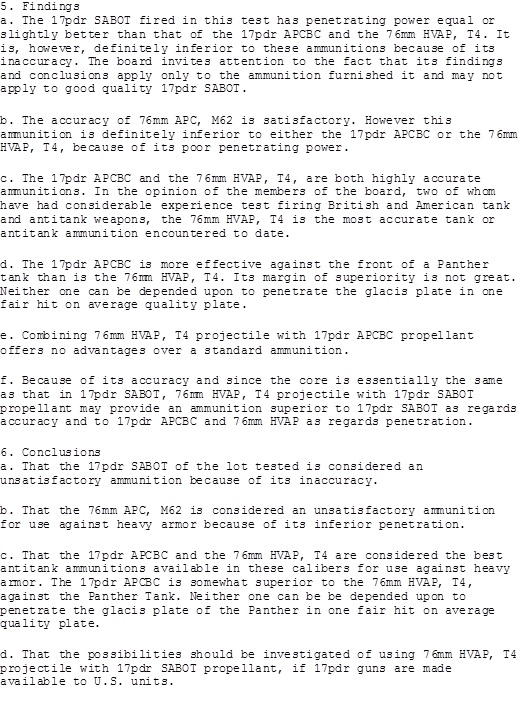
Not particularly reassuring. The best anti-armor round then available to US forces in any quantity, the M62, is rejected as unsatisfactory for use against heavy armor. Two more capable rounds, that are not available to US forces but perhaps could be in the future, the new 76mm HVAP and the British 17pdr APC, are accurate enough but can’t reliably penetrate a Panther. The one round that can reliably penetrate a Panther isn’t accurate enough, even if it were available to US forces.
In the meantime, production of HVAP was ramped up to at least give a fighting chance, and in September the first 90mm-armed M36 tank destroyers were brought into France and issued to TD units.
LEARNING THE LESSON A SECOND TIME, FALL AND WINTER, 1944/45
After the “Panther Crisis” of July, 1944, and the set of tests conducted by First Army and 12th Army Group at Isigny in France, US Army Ordnance upgraded its testing and evaluation methodologies to ensure it would not be surprised again. New production techniques were used to improve the performance of existing AP projectiles. The new HVAP projectiles were put into production, although throughout the Autumn the production ramp was slow, and they were never available in the intended quantities.
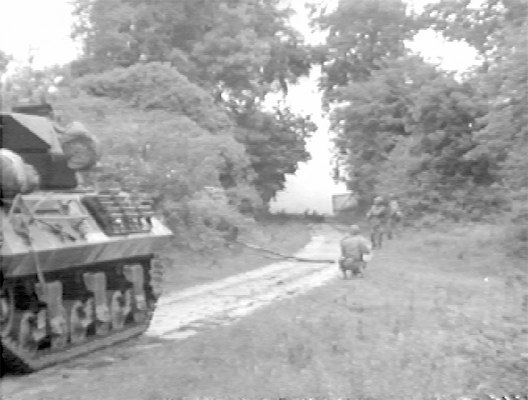
M10 in Normandy
Tests aside, though, throughout the Autumn of 1944 US Army commanders in the European Theater of Operations (ETO) went silent on the issue. The opinions from ETO on the firepower of US tanks went through a remarkable see-saw ride in 1944.
In July there was shock and anger over how poorly US tank guns performed against German armour. By late August, when real test data showed just how badly US guns under-performed, no one cared any more. Independent tank battalions equipped with M4s were leading US infantry divisions into battle, and armoured divisions equipped with more M4s were leading the charge across France: It seemed nothing could stop them. It was not until the Winter, with the return of positional warfare, and then the German offensive in the Ardennes, that questions were once again raised about the performance of US guns and ammunition vs. German armoured vehicles.
COMBAT EXPERIENCES: Beyond What the Tests Showed
The reports issued after two sets of firing tests at Isigny painted a bleak picture of the capabilities of the Sherman’s existing 75mm gun, as well as the new 76mm which was being used in up-gunned models. The tests showed that the 75mm gun could not penetrate a Panther’s front from any range.
However, combat reports indicated that the 75mm actually could, on rare occasions, penetrate a Panther’s front. The mantlet of the early Panther was rounded. If a shot struck either the top or the bottom quarter of the mantlet, it tended to ricochet off due to the slope. Those striking the bottom quarter ricocheted downward from the turret face, which meant that the projectile could go on to strike the turret ring or the hull roof of the driving compartment, behind the driver or co-driver’s hatch. Here the armor was thin, and rounds that bounced off of the mantlet often jammed the turret or even penetrated through the hull roof.
British crew reports in particular speak of the deliberate tactic of aiming for the lower half of the turret front. Perhaps they found it more productive, given the British preference for solid shot. The US standard was an exploding AP shell, and as the Shoeburyness test indicated there was a substantial chance that the round would detonate before it penetrated a second plate. Still, regardless of the projectile, hitting the lower rounded portion of the mantlet was no easy feat – it meant shooting for a target about 6 inches high.
The 76mm, using its main AP round (the M62 APC), could not penetrate the front of the hull at any range, but could penetrate the mantlet at about 200yds or less. Again, though, the rounding of the mantlet played into the issue. Striking the top quarter of the mantlet could well lead a projectile to ricochet off into the sky. As a result, crews needed to hit the mid half to penetrate the turret, or the lower quarter, to have a chance of ricocheting into the hull roof. So with an M18 or up-gunned M4, the crews managed to gain an advantage of perhaps another 10-12 inches of target area on the Panther’s almost 10-foot high frontal aspect.
Adding an HVAP round, though, made the hull front of the Panther vulnerable. Well… somewhat. The lower front hull was vulnerable, though the glacis evidently was not, but even when impacting the lower hull penetration wasn’t a reliable outcome. It turned out that the original 76mm HVAP round T4 was not at its best against highly sloped plate: It had a greater tendency to ricochet than most other projectiles. During the Autumn and Winter there were at least two production changes to improve the metallurgy of the round, with the T4E17 version dominating Autumn production, being replaced by the T4E20 version about the end of the year, and eventually being standardized as the M93.
Still, performance against highly sloped plate still didn’t attain what the Army wanted until the post-war M319 HVAP round, which not only had an improved penetrator but also higher velocity due to improved powder. This became the US Army’s standard anti-tank round for the M4 in the post-war years, performing very well against Soviet-made T-34/85s in the Korean war.
That was the future, though: In 1944/45 the T4 / M93 HVAP round was the best that a Sherman tank could have to face Panthers … when there were any to be had, that is.
While they were different guns with different cartridges, the US 76mm and the 3-inch guns fired the same projectiles, at the same velocities. After the Isigny tests, production was immediately ordered on the T4 for both the 76mm gun of the Sherman and M18 tank destroyer, and the 3" gun that served as a towed gun and in the M10 tank destroyer. The initial production order was for 20,000 rounds. Then a target of 43,000 rounds per month was set for the remainder of the year, and 10,000 rounds per month thereafter. Production was slow to ramp up. The tungsten carbide steel used as the core of HVAP rounds was a critical war material, and was in demand for many wartime production requirements. Shooting it out of barrels at the Germans was a new requirement that only added to the stress on supplies. The 43,000 per month target for 1944 was quickly abandoned. Even the more modest rate of 10,000 per month was not reached until November of 1944.
The first 1,000 rounds of 76mm T4 produced in July were sent by air to ETO in time for the Isigny tests. The portion that remained after testing was issued to the troops. A second shipment of 1,000 3" T4 rounds was also shipped by air, in August. But after that, the rest came by normal surface shipping. After August, the receipt of HVAP rounds for the 3-inch and 76mm guns through the end of the campaign in ETO was:
Month / Year
3-inch HVAP
76mm HVAP
Sep 1944
1,000
1,000
Oct 1944
2,000
1,000
Nov 1944
5,000
5,000
Dec 1944
5,000
5,000
Jan 1945
7,000
6,000
Feb 1945
6,000
6,000
Mar 1945
3,000
9,000
Apr 1945
3,000
5,000
May 1945
0
6,000
Normal shipping time for munitions from the US to ETO ran about 10 weeks. It was not until mid-January that HVAP rounds received in ETO exceeded 2,000 per week. Priority was given to the M18 tank destroyers units for the few 76mm T4 rounds that initially came in to ETO. It was only in 1945 that tank units received enough HVAP ammunition to carry the oft-quoted 2 or 3 rounds per tank.
During this same timeframe towed tank destroyer units were turning in their 3-inch guns for self-propelled tank destroyers, and those mounted in M10s were progressively replacing their 3-inch GMCs with 90mm M36 GMCs, and so production of 3-inch rounds began to tail off in 1945, closing out production by the time hostilities in ETO came to a close. In the meantime, the first 90mm-armed M36 tank destroyers were received in France and issued to TD units in September of 1944. After very quick orientation and training those TD units returned to the front, and the M36 saw first action in October. It was an immediate hit.
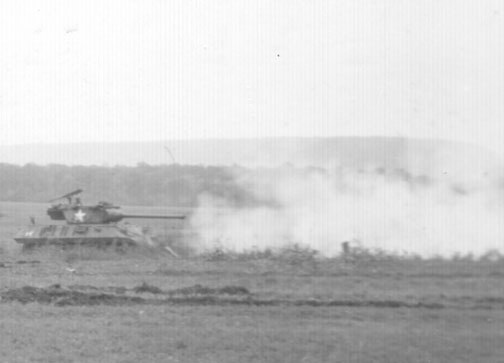
The Tank Destroyer Board in the US had no particular enthusiasm for the M36. The tank destroyer doctrine called for high mobility as well as firepower. The M10 had been accepted as a stop-gap design, to fill the ranks while the TD board’s own newly designed vehicle was perfected and built. That vehicle, the one that the TD board wanted, was the M18. Up-gunning to a vehicle which shared the M10’s relatively lethargic automotive performance was not in keeping with the doctrine of the tank destroyers. But the troops often saw differently, not least because doctrine was almost never followed to begin with.
TD troops seem to have held their equipment in high regard no matter what they were equipped with, as long as they were self-propelled. Whether they were driving M10s, M18s or M36s the TD men responded positively to questions about their gear. But infantry units in particular were very effusive in their praise for the M36 with its 90mm gun, and preferred it greatly to the other TDs. This is reasonably easy to understand. The infantry could not “maneuver” in response to the panzers, but rather had to stand their ground, relatively speaking. They took far less comfort in tank destroyers that could scoot away and reposition for an advantageous engagment later. They took much more comfort in tank destroyers that could stand with them in the line and fight it out with the panzers head-to-head. The larger HE round probably didn’t hurt either.
So we have the stage set on paper: the Panzer Divisions are re-equipping with Panther tanks; the 75mm is not adequate against the Panther’s front armor; the 76mm gun is only little better, unless it has its “magic bullet” HVAP rounds; the HVAP offer at least some chance of dealing with the big cats frontally, but they are in woefully short supply. And while the M36 redresses the firepower issue, there is a real scramble to make enough of them to go around, using any hulls they can find.
But despite this, the reality was that the commanders in ETO didn’t seem to care.
GOOD ENOUGH – Autumn 1944: The Breakout, Falaise, the Race to the Seine, and Beyond!
When studying the details, it is easy to lose track of the broader picture. So beyond the details of whether US tankers had 6 inches or 18 inches of target area on a Panther, what did they think of the M4?
Following are a selection of comments by tank unit commanding officers extracted from reports made from troop survey visits in the fall of 1944. Note that tank battalions with 2-digit numbers were part of the armored divisions, while those with 3-digit numbers were independent tank battalions operating with infantry divisions. (Special thanks to Rich Anderson, author/historian for these)
Headquarters Twelfth Army Group, Armored Section
6 October 1944
Subject: Visit to XII Corps Armored Units.
7. a. We visited Lt Col Abrams, C.O. 37th Tank Bn, 4th A.D. on 3 October. Col. Abrams stated that his battalion thought very highly of the 76mm gun. They felt the HE was as good or better than the 75mm and apparently had more blast effect. They were highly pleased with the ease at which they were able to hit the German tanks at ranges from 1500 - 1800 yards. …
b. Col Abrams does not believe in using extra sand bags on the front of tanks and carries extra track blocks for use as spares only. …
9. a. Visited Lt Col F.M. Kroschel, C.O., 737th Tank Bn, on 4 October. …
d. …He complained of lack of time for rest and maintenance. The Infantry C.O. does not realize the amount of time required for maintenance of armored vehicles…
f. … He felt that light tanks were not much use to the infantry as they could not take the slugging that they had to take as they were too thinly armored.
h. …He would like to have additional 105mm How tanks with power traverse and stabilizer to replace 75mm gun tanks up to one company in the Battalion.
10 October 1944 Subject: Visit to Ninth Army Armored Units.
2. Tactical employment of separate tank battalions:
a. The 709th Tank Battalion, in supporting the 8th Division, normally is allotted down to the point where one platoon is attached to each infantry battalion. This attachment is continued regardless of terrain or mission when in combat. Tank companies are not employed tactically as such. …
b. The 746th Tank Battalion is normally allotted one company to each infantry regiment and the company normally supports the battalion making the major effort or which is in the assault. The company commander is allowed considerable latitude in maneuvering his platoons…
j. Both battalion commanders are emphatic in their recommendation that a tank battalion be organically assigned to each infantry division…
k. During the early stages, infantry commanders were reluctant to accept any recommendations of the tank unit commander concerning tank employment. This situation has greatly improved. Tank unit commanders are freely consulted with a resultant improvement in overall combat efficiency and success.
2. [sic] Weapons and Gunnery.
a. The 105mm tank is well liked for its fire power. Battalion C.O. 741st Tank Battalion would like one platoon per company (with power traverse)…
14 October 1944
Subject: Visit to Armored Units XII Corps.
2. Organization. The 6th Armored Division likes the organization of the division generally but have the following suggestions.
a. The – 8 [sic: 9] 57mm AT guns in Armored Infantry Battalion are not desired due to being hard to manhandle and get up close enough to support the action. They have turned in all but three and armed the crew with M-1 rifle giving them additional riflemen.
b. More armored infantry is desired in the Armored Division…
3. Equipment.
a. The 6th Armored Division has received no 76mm tanks and have no great desire for them…
c. The 105mm tank is liked very much. Would like them in proportion of one platoon per medium tank company.
16 October 1944 Subject: Visit to First U.S. Army.
3. Assault Tanks – M4A3E2
h. Personnel were particularly enthusiastic of the Ford engine (only radials prior to this), sighting equipment (M71G Telescope), and the ammunition stowage (wet).
24 October 1944 Subject: Visit to Armored Units of the XX Corps.
3. 735th & 712th Tank Battalions.
c. Both Battalion Commanders agreed that it would be desirable from a tactical and supply point of view to have the Tank Battalion an organic part of the infantry division.
d. Assault Gun Platoon. – The Assault Gun Platoon has been used to considerable extent, but the additional production of assault guns next year and consequent incorporation of this weapon within the tank company would render the separate Assault Gun Platoon unnecessary.
e. Light Tank Company. – Co, 735th Tank Battalion feels that the Light Tank Co has very little application in support of infantry divisions and that in the interest of simplifying the Separate Battalion organization the Light Tank Company could well be omitted. CO, 712th Tank Battalion has found the Light Tank Company extremely useful on special missions, particularly for pursuit, and would be reluctant to give it up.
4. Equipment.
b. 76mm Gun. – The opinion of tank commanders of the 735th Tank Battalion were divided regarding the 76mm gun. … Most of the direct fire using the 76mm gun has been at short ranges where the effects of the blast are most noticeable. The 712th Tank Battalion had not used their 76mm guns for direct fire and had formed no opinion regarding the gun. Their 76mm guns are on the M4A3 chassis which they consider far superior to the M4A1. There were no adverse effects of the 76mm.
Tank battalion commanding officers apparently had lots of opinions, and no hesitation in expressing them. They offered many comments on the tanks they used. Sometimes the commanders contradicted each other, but some issues were repeated often to for us to see patterns in their concerns. They liked the firepower of M4(105)s, and wanted a few more than the one platoon per battalion that the TO&E gave them. They didn’t seem to be quite as pleased with the company of light tanks that they were authorised. They liked the performance of the Ford GAA engine in the M4A3. They liked the armor of the M4A3E2 “Jumbo”
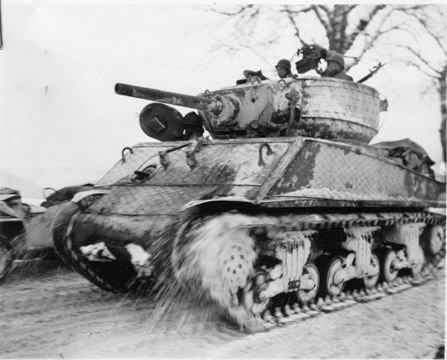
Notable by its absence was any expression of panic, or even concern, that they didn’t have the equipment they needed to deal with the Panzers.
What happened to the Panther Crisis of July? Quite simply, it got lost in all the success.
Let us look, for a moment, at the timeline of accomplishments of the US 12th Army Group in ETO during this time. To give the proper context for these accomplishments, let us recall two things.
First, recall the timeline for the second test conducted at Isigny, using first shipment of HVAP ammunition to be rushed to ETO – the test that really demonstrated the under-performance of the very best that was in the near-term pipeline for US tankers. The test firings began on 20 August. The preliminary report was written on the 22nd, and the final report became available for distribution on the 30th of August.
Then, second, consider the originally planned timeline for the post-landing offensives in ETO, which had been drawn up by Field Marshall Montgomery (in charge of planning for the land campaign). The plan was built on a series of phase lines. It called for reaching the phase line of the river Seine by D+90 (4 September), and then pausing to assemble sufficient manpower and materiel to force a crossing of this major obstacle, which was expected to be one of the Germans’ main defensive lines.
Now compare those dates to these:
1 August: US Third Army breaks out of the Normandy boccage country at Avranches.
19 August: US 79th Infantry Division, of XV Corps / Third Army, reaches the Seine at Mantes-Gassincourt, about 20 miles “above” (north-west of) Paris. That same night General Bradley approves General Patton’s plan for crossing and establishing a bridgehead.
20 August: On the day the test firing begins at Isigny, the bulk of 79th Division crosses the Seine with 3 infantry regiments, a tank battalion, a tank destroyer battalion, AA and artillery. Advanced patrols capture an underground bunker command post of German Army Group B at La Roche Guyon.
22 August: On the day that the preliminary report from Isigny is written, Canadian First Army closes the Falaise gap, trapping about 60,000 troops of Army Group B. Army Group B is left with only about 30,000 troops, 314 guns, and about 60 tanks. These are ordered to withdraw over the Seine via ferries at Rouen to set up a defensive line, while leaving a bridgehead on west bank of the Seine as a rearguard. This rearguard prevents a rapid crossing by British 21st Army Group, but poses no obstical to US 12th Army Group.
The Seine itself is no longer a geographical barrier. On that same day the US 5th Infantry Division of XX Corps crosses Seine at Fontainebleau below Paris.
23 August: US 10th Infantry Division, 11th Infantry Division, and 7th Armored Division all make crossings of the Seine.
25 August: By this time the US 12th Army Group has five firm bridgeheads over Seine: one above Paris, and four below.
Recognizing the hopelessness of his position, and contrary to explicit orders from Hitler, the German commander of the Paris garrison, General von Cholitz, surrenders the city to the General Leclerc’s French 2nd Armoured Division (operating with US First Army). All of the bridges over the Seine within the city are intact.
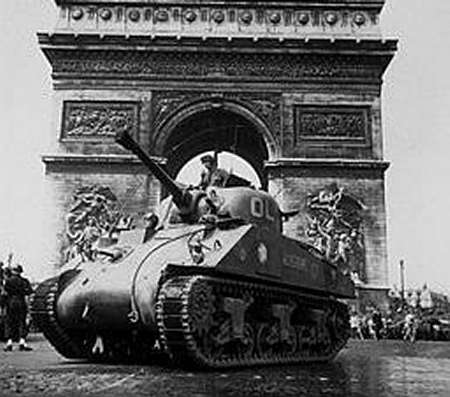
30 August: The last German unit retreats across the Seine.
31 August – 2 September : US XIX Corps advances to the Belgian boarder – US 2nd Armored on left, 79th Infantry in center, 30th Infantry on right all move together. 79th Infantry Division advances from Mouy to St. Armand, then crosses into Belgium, pushing a salient 180 miles deep into enemy territory, in a period of 72 hours.
The confines of the boccage had been overcome. Once the US Army had achieved freedom of maneuver it moved so quickly, overcoming or by-passing German positions so rapidly that the Germans could not organize a defense. Ever since a cadre of US Army officers had observed and studied the German campaign across France in 1940, the doctrines, plans, training, and weapons had been developed for this. It was all working. The paper specifications may have said that the Germans should be able to stop the American tanks, but it seems that nobody told the crews of the M4s this.
In the US Army the armoured divisions, and even the infantry divisions, had a level of mobility that no other army could match (although by this time the British came very close). The US Army was not bound to the rail infrastructure. That was a good thing, as the allied air forces had spent months pulverizing the rail lines and marshalling facilities across Europe, and particularly across France. The US Army had enough trucks in ETO to move entire divisions by road (though not every division at once). The artillery was motorized, unless it was self-propelled (which was even better). And the supply echelons were motorized. Everything that was not a motor vehicle moved as cargo in a motor vehicle. Once on the move, no other nation could react to the American speed.
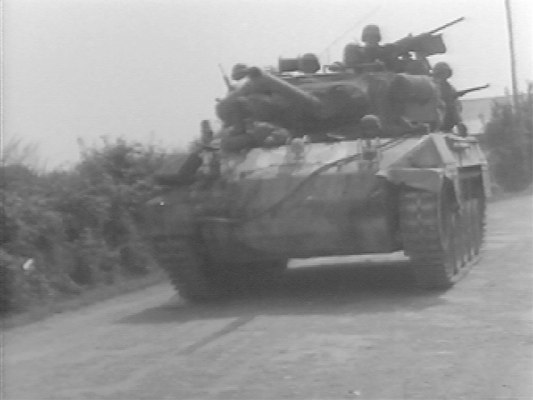
An M18 moving towards the Seine after the breakout
Almost every US infantry division in ETO had an independent tank battalion and a tank destroyer battalion assigned to co-operate with it. This gave them effectively about as much armour as an average Panzer division, providing both firepower and mobility. In the German army the only independent tank battalions were the Heavy Panzer Detachment (ie: Tiger) units. Only three of these were available during the Normandy campaign. The best that most German infantry divisions could hope for was the occasional support of assault gun (Sturmgeschutz) batteries.
There is a common belief that the allies needed a 5-to-1 advantage to fight the Panzers. If this had been true the allies would have been thrown back into the sea, as there was no time during the campaign when they had so great of an overall advantage, and the restrictions of the terrain made it very difficult for them to use their superior mobility to concentrate forces at that level on individual battlefields. But fortunately this old saw is nothing but a myth. The British Army Operations Research surveyed the tank battles of Normandy and came to some interesting conclusions on this issue. Their Memorandum C6 (W/O 291/1218) examined all of the tank engagements from D-Day to 12 August, 1944, and observed that, in a tank vs. tank engagement, the allies always achieved victory when they held a 2.2-to-1 numerical advantage or better.
But that did not mean less than a 2.2-to-1 ratio resulted in a loss. The Germans, despite being on the defensive and having heavier tanks, needed a 1.5-to-1 numerical advantage to ensure their own success. In between those ranges it was a mixed bag dependant on many tactical considerations
This is the bigger picture. The tank was the single best weapon for bringing firepower, protection and mobility to the battlefield. The allies’ superior mobility allowed more tanks to reach the decisive point, often a place and time of their choosing, again and again. The allies’ superior number of tanks allowed not only armoured divisions, but even infantry divisions, to apply the tank’s firepower where and when it was needed. So long as the allies could bring more tanks to the battle, and even more importantly could bring tanks to more battles, the question of who had better tanks had little impact on the conduct of the campaign.
An example of how well the M4 could perform was seen in the armored battles in Lorraine.
In September, 1944, the US Third Army was across the Moselle River in the vicinity of Nancy. The Germans launched a series of armored counterattacks with the intention of restoring their line and crushing the over-extended U.S. spearheads of 4th Armored Division. The 21. Panzer Division and 15. Panzergrenadier Division led the attacks. Third Army stripped troops from uninvolved units to counter this attack on the bridgehead. This left Combat Command A (CCA) of 4th Armored Division isolated near Arracourt and generally under-strength.
Rather than distributing all of the tanks coming in as replacements across many panzer divisions which would still inevitably be under-strength, the Germans had instead siphoned off many of the new tanks to create a number of Panzer Brigades. These were powerful armor-heavy units without the tail of a division – spears that were all blade and little shaft. At 0730 on September 19, 1944, the German 113th Panzer Brigade slammed into Combat Command A.
CCA at this time had only one company of M4 tanks forward, with a company of M10 tank destroyers in reserve. 113th Panzer Brigade hit them with four companies of Panther tanks and a company of assault guns, along with two battalions of panzergrenadiers (armored infantry).
But one of the prices the Germans paid for creating new units, rather than re-building the existing cadres of their panzer divisions, was that the panzer brigades were inexperienced and under-trained. And they were fighting veteran US crews on a battlefield that allowed the US forces room to maneuver.
CCA of the 4th Armored Division was equipped mostly with 75mm-armed M4 tanks. They fought a series of delaying actions from ambush positions which bled the 113th Brigade every step of the way, slowed their advance, and reduced their cohesion. A second company of M4s arrived as re-enforcements. Once the Germans paused to regroup, CCA launched its own attack out of the fog, rolling up the German flank, and all but annihilating 113th Panzer Brigade.
The next day as they surveyed the battlefield the Americans counted forty-three knocked out German AFVs, almost all of them Panthers. German losses were actually greater than that, but they had managed to recover several knocked-out tanks as they withdrew. The two battalions of panzergrendiers had been shattered as well – overrun and scattered, suffering over 500 casualties.
And what price did the Americans pay for this victory? Six soldiers had been killed, thirteen soldiers wounded. Three M10s and five M4 tanks had been knocked out.
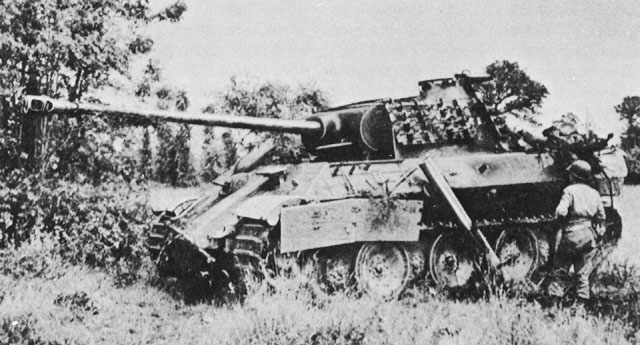
CCA 4th Armored Division did not win with overwhelming airpower or artillery support. Fog kept the airplanes home and made it almost impossible to bring down heavy fire concentrations on the Germans. The battle was almost exclusively a match between the armored forces. Nor did the Americans win due to overwhelming numbers. Overall they were outnumbered in both tanks and infantry. They won because they out-maneuvered their enemy, and concentrated forces for the decisive punch.
The commander of CCA’s tank battalion, Lieutenant Colonel Creighton Abrams, went on to become one of the most celebrated American armored commanders of World War II.
The rapid advances and stream of victories in the fall of 1944 did not mean there were no losses. Tanks were lost in combat with other tanks and SPGs, they were lost to mines, to infantry AT weapons, and with so much movement some of them just wore out. The British Army, based on their experiences in North Africa, had established enough of an overstock to keep up with losses. The US Army maintained a smaller overstock, and by September was falling behind on replacing losses. Some Sherman units were forced to operate without their full complement of tanks.
In a twist of fate the shortage of replacement M4s actually prevented the US Army from getting one of the better weapons for fighting the heavy panzers. By the summer of 1944 British arsenals that were converting Shermans to the Firefly configuration with the 17pdr gun had finished their conversion of the 600 Fireflies required by the British TOEs. After the summer’s testing had demonstrated the slight superiority of the British 17pdr, Eisenhower requested a number of Fireflies be converted for the US Army. But the question of where the tanks would come from could not be resolved.
The base M4 was the only model in service with both British and US armies for which a Firefly conversion had been designed (the M4A4 was also used for the Firefly, but the US Army did not use that model overseas). The British had stocks of M4s, but were determined to preserve their surplus for their own replacement needs, and insisted that US Army stocks be used for conversions. But the US Army had no excess of M4s … units were already under strength, and commanders were screaming for more tanks right now, no matter what gun was on them. So none were provided for conversions. Besides, the improvement in firepower was slight compared to the 76mm, so the issue wasn’t pressed.
By the time the US Army caught up on M4 replacements in late Fall, the British had increased their war establishment from 36 to 72 Fireflies per Brigade, and the arsenals were again busy doing British conversions. In the end it was not until the spring of 1945 that the British did, in fact, convert 81 Fireflies for the US Army. By that time, however, the US Army in ETO was receiving 90mm gun-armed M26 tanks in increasing numbers, and there was no further interest in Sherman Fireflies.
If the US was short of M4s, they were wallowing in equipment compared to the Germans. Most panzer divisions had not been at full authorized strength since 1941. In 1944 panzer divisions were authorized to have two battalions in their panzer regiment, one of Pz IVs and one of Panthers. Each battalion was authorized to operate four companies of 22 tanks each, for a total authorized tank strength of over 170 medium tanks, plus StuGs, tank destroyers and recon vehicles. But in 1944, even when rested and replenished, panzer divisions were almost never at full strength. A panzer division was lucky to have more than 100 operational tanks and tank destroyers combined.
However, after the Normandy campaign it was no longer a question of how close a panzer unit was to full strength – the Panzer forces in France had almost no strength left at all. They had been crushed.
Here are the reported strengths of the 10 panzer divisions of Army Group B on 22/23 August, 1944:
2. Panzer: 1 infantry battalion, no tanks, no artillery
21. Panzer: 4 weak battalions, 10 tanks, artillery unknown
116. Panzer: 1 infantry battalion, 12 tanks, approximately two artillery batteries
1st SS Panzer: weak infantry elements, no tanks, no artillery
2nd SS Panzer: 450 men, 15 tanks, 6 guns
9th SS Panzer: 460 men, 20-25 tanks, 20 guns
10th SS Panzer: 4 weak infantry battalions, no tanks, no artillery
12th SS panzer: 300 men, 10 tanks, no artillery
(9th Panzer and Panzer Lehr provided no reports. Both divisions had been destroyed)
Added to this were three Schwere Panzer Abteilungs (Heavy Tank Detachments) that were involved in the Normandy campaign: 501st, 502nd and 503rd. These had brought a total of 132 Tigers into action. Between the three they reported no operational Tiger tanks remaining (the last four were lost trying to cross the Seine by ferry).
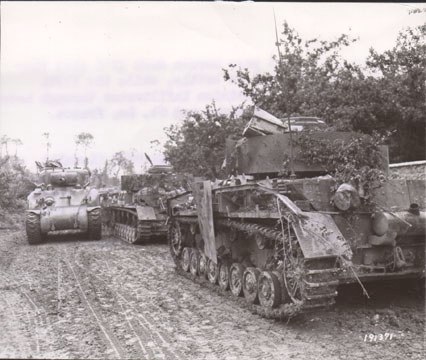
A US Army M4A1 passes knocked-out Pz IVs in France
It was a happy time for the M4. It was what the tank, and the US Army’s armored divisions, had been made for.
And then … the forward troops reached the end of their supply lines. The few port facilities that had been taken were not yet functional, and it just wasn’t possible to move enough material over the beaches, even if the US Army had worked out how to carry it forward several hundred miles by truck. The front stopped advancing, and settled down. This gave the Germans enough time to organize their defenses and rebuild some of their strength.
It was time for the lessons of July to be learned again.
NO LONGER GOOD ENOUGH – Winter 1944/45: The Siegfried Line, the Bulge and the Fall of Germany
Combat became positional, more a question of firepower than maneuver. The rain and snow began to fall. The roads and fields alternated between muddy and icy. M4s, M10s and M36s struggled in the mud. And the Panzers came surging forward down the narrow lanes of the Ardennes forest, leading with their heavy armor. US Army infantry divisions that had been roughed up in the slogging match of the Huertgen Forest, and green units new to ETO, were hit by fast-moving Panzer units lavishly equipped with Panthers and Tiger 2s.
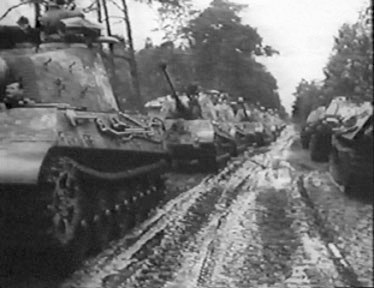
King Tigers move up a narrow road in the Ardennes
Armoured divisions, independent tank battalions and tank destroyer battalions were all involved in fighting back in the Ardennes.
By this time the M36 90mm tank destroyer was coming into service in greater numbers, but the majority of tank destroyer battalions were equipped with the 76mm gun in M18s, or the 3-inch gun in M10s, or even the towed 3-inch guns. M36s were mostly issued to the M10 units as replacements, to bolster their firepower. But there were not enough M36s to fully re-equip most M10 units, particularly as the towed gun battalions were all also being re-equipped with self propelled tank destroyers (This can be the subject of an entirely different article, and is a case of equipping to fight the last battle). And so the M10, which was available in numbers, continued to soldier on.
Even with the 3-inch and 76mm guns, the crews of the tank destroyers performed well. However, the positional warfare and the battles in the forests of the Ardennes, which provided so little room for maneuver, once again soured the opinion of tankers against the M4. American forces continued to fight on to victory, but with equipment that most US tankers now considered entirely outclassed.
In March of 1945 General Eisenhower wrote a note to General White of the US 2nd Armored Division, asking if some of his experienced officers and NCOs could assemble their views on the qualities of US versus German tanks. General White replied within 2 days with a digest of his own views and the views of the officers leading his combat commands and his tank battalions. The effort expanded beyond the original intent into an expansive report examining a great variety of equipment, not just tanks
The report included observations on American vs. German tanks from a variety of officers in the 2nd Armored:
A.P.O. 252
20 March 1945
Supreme Commander Supreme Headquarters Allied Expeditionary Force
My dear General Eisenhower:
In this letter I am setting forth my personal convictions as to the quality of our tanks and certain other items of equipment in comparison with the German, as you requested in your letter of 18 March 1945.
I have enclosed a separate document giving a digest of the opinions of officers and enlisted men who have had much experience and in whom I have great confidence. I have also included a large number of the actual statements made by them. Allowing for the traditional enthusiasm displayed by the American soldier when he is given (or takes!) the opportunity to express himself in regard to any possible shortcomings in his rations, clothing and equipment, I think they are sincere, reasonably factual, indicate considerable thought and knowledge of the subject, and above all, they are most refreshing. I have not edited them in any way and I believe they are a true cross-section of opinion of the command.
I feel that many criticisms made by tank crews would not appear had we been equipped with a larger proportion of M4A3E8 tanks for Operation “Grenade.” Only two or three tanks of this type actually saw combat. During this operation only twenty-nine percent of our medium tanks mounted 76-mm guns, and only four rounds of HVAP ammunition per 76-mm gun was available. Incidentally, rounds of this type expended in this operation have not been replaced. However, the 76-mm gun, even with HVAP ammunition, is not effective at the required ranges at which we must be able to effectively engage enemy armor.
The following are my personal convictions pertaining to the items listed:
Ordnance Equipment
The major items of ordnance equipment are sound in design from a mechanical standpoint, particularly with the changes in suspension of the M24 light tank and M4A3E8 and M26 medium tanks. Any increase in armor plate thickness would decrease speed and maneuverability and it is felt that these highly desirable characteristics should not be sacrificed. The main armament of our tanks, including sights, is not comparable to that of the Germans.
Tank, Light: The M5 light tank should be replaced with the M24 light tank as soon as possible. The latter is a highly satisfactory tank in every respect. Every effort should be made to improve the gun, sights and ammunition. The M5 light tank is obsolete in every respect as a fighting tank.
Tank, Medium: The M4A3E8 has comparable speed and maneuverability to any German tank. The 76-mm gun is reasonably satisfactory, provided sufficient HVAP ammunition were available. If it were possible to design and substitute a long barrel piece with muzzle brake and approximately 3400-3500 feet per second muzzle velocity, similar to the German 75-mm HV tank gun, this tank would be equal to anything our enemies have to offer.
The M26 medium tank has not as yet been issued to this division and consequently no comments can be made. Experience with the M36 tank destroyer with 90-mm gun indicates that this should be a highly effective tank when HVAP ammunition becomes available. Its issue to this division is eagerly awaited.
Tank Destroyer, M36: Has not lived up to expectations, but when HVAP ammunition becomes available it is hoped that it will be more effective. Fighting compartment precludes efficient service of the piece and available ammunition is not effective at required long range.
M4A3E8 Assault Tank with 105-mm Howitzer: An ideal weapon for purpose for which designed. Turret should have power traverse.
…
The most important point, and upon which there is universal agreement, is our lack of a tank gun and anti-tank gun with which we can effectively engage enemy armor at the required range. The correction of this deficiency has made progress, but the problem has not as yet been satisfactorily solved.
I would like to express my sincere appreciation for this opportunity to write you informally on these matters which are of such immediate concern and importance.
Sincerely yours, [signed] Isaac D. White
Colonel Paul A. Disney Commanding 67th Armored Regiment
Armor: Insufficient to prevent penetration by high velocity ammunition used by German tanks and anti-tank weapons.
Armament: Both 75-mm and 76-mm guns with available types of ammunition are incapable of neutralizing enemy tanks at ranges at which the latter are capable of neutralizing our tanks. When engaged at closer ranges with HVAP [high velocity armor piercing], 76-mm guns have disabled German tanks but penetration of armor seems to be rare. …
I believe the necessity for equipping troops with tanks capable of engaging enemy tanks on an equal basis outweighs all other considerations. Being close to the using personnel I am acutely aware of the morale factor involved in equipping troops with present tank equipment.
My opinion as to ability of M26 with 90-mm gun to meet Panther and Tiger on equal terms is based only on knowledge that present tank destroyers equipped with 90-mm gun and 'souped up' ammunition have been able to knock out such tanks where 75-mm and 76-mm guns were unable to. It is therefore reasonable to believe that a more equal footing would be obtained by supplying the M26.
Brigadier General J. H. Collier Commanding Combat Command "A"
The consensus of opinion of all personnel in the 66th Armored Regiment is that the German tank and anti-tank weapons are far superior to the American in the following categories:
…
The German guns have a much higher muzzle velocity and no tell-tale flash. The resulting flat trajectory gives great penetration and is very accurate.
The 90-mm, although an improvement, is not as good as either the 75 or 88. If HVAP ammunition becomes available, it will improve the performance of both the 76-mm and 90-mm guns. …
German tanks have better sloped armor and a better silhouette than the American tanks.
The M24 tank has not been available long, but has created a very favorable impression.
It is not possible to comment on the M26 tank, as we have had no experience with it. …
It is my opinion that press reports of statements by high ranking officers to the effect that we have the best equipment in the world do much to discourage the soldier who is using equipment that he knows to be inferior to that of the enemy.
Lt. Col. Wilson M. Hawkins Commanding 3rd Battalion, 67th Armored Regiment
…
My personal opinion about the comparative quality of U.S. and German tanks can be stated briefly as follows: if such a choice were possible, I would prefer to fight in the present German Mark V or VI tank against the present U.S. medium tank and tank destroyer with the 90-mm gun. … The feeling among the tank crew personnel, men who have four, five and six full campaigns to their credit, is the same. …
Our M4 tank does not compare favorably with the German Mk V or VI in armor plate. Theirs is much thicker than ours and sloped so as to prevent strikes against it at angles approaching the normal. I have inspected the battlefield at Faid Pass in Tunisia, being with the force which retook it. Inspection of our tanks destroyed there indicated that the 88-mm gun penetrated into the turret from the front and out again in the rear. Few gouges were found indicating that all strikes had made penetrations. Our tanks were penetrated by 88, 75, and 50-mm caliber in this engagement in all parts of the hull and turret. I personally measured many of the holes.…
The tank gun is the most vital factor in tank fighting. I know of many cases to prove the fact that the German 75-mm and 88-mm mounted on Mk IV, V, and VI tanks will penetrate our tanks, while our weapons will not penetrate theirs at the same range. Many tests have been made and results have been published of these facts. We have been out-gunned since Tunisia, when the Germans brought out their Mk IV Special with the long-barreled 75-mm gun. The higher muzzle velocity of the German guns increases their accuracy, as range estimation are of less importance with such a flat trajectory. I have fired all our tank weapons and know this to be so. Our 76-mm gun is a big improvement over the 75-mm. …
Some of my tank crews claim penetrations on the front plate of Mk V tanks, using the 76-mm gun and HVAP ammunition (3400 feet per second). They have more confidence in this combination than any other we have. So far, however, we have never been able to supply a tank with more than two or three rounds of this ammunition. We have been unable to obtain it. So far, we have been unable to obtain more than seven tanks out of seventeen mounting a 76-mm gun. So far, in this battalion, I have three tanks with the wide E8 suspension and track out of a total of fifty-four tanks.
Tank crews in this battalion are adding sand bags to their tanks, about 170 bags for each tank, in an effort to make up for the tank's lack of armor and the penetrating ability of German guns.
Harold A. Shields, First Lieutenant Company "A," 66th Armored Regiment
On 2 March 1945, the 2nd Battalion, 66th Armored Regiment, was making a drive to the Rhine River. Upon taking the battalion objective at Fichlen, Germany, three of our medium tanks were knocked out by a German self-propelled gun (a long-barreled 75 on a Mark IV chassis). I took this self-propelled gun under fire with my platoon of M24 light tanks at 800 yards. The platoon fired a total of twenty-five rounds, the majority of which were AP. None of the AP pierced the front slope plate of the self-propelled gun, but ricocheted off. Some medium tanks from "I" Company, 66th Armored Regiment, with 76-mm guns, also fired on this self-propelled gun, and their rounds also ricocheted off. The range these tanks took the self-propelled gun under fire was approximately six hundred yards. It was impossible to fire at the side of the self-propelled gun as it was in position between two buildings, so it had to be taken under fire from the front. The next day, 3 March, I went to look at this self-propelled gun. None of the AP rounds had penetrated the front. The rounds had made a few dents in the armor plate and then ricocheted off. [Note, however, that given he was able to examine the gun, the US Army appears to have still been able to win the fight with the equipment at hand –Chieftain] I also examined the three tanks that had been knocked out by the German self-propelled gun. In all cases the German rounds had penetrated all three tanks and in one case had penetrated the turret of one tank on one side and had gone out the other.
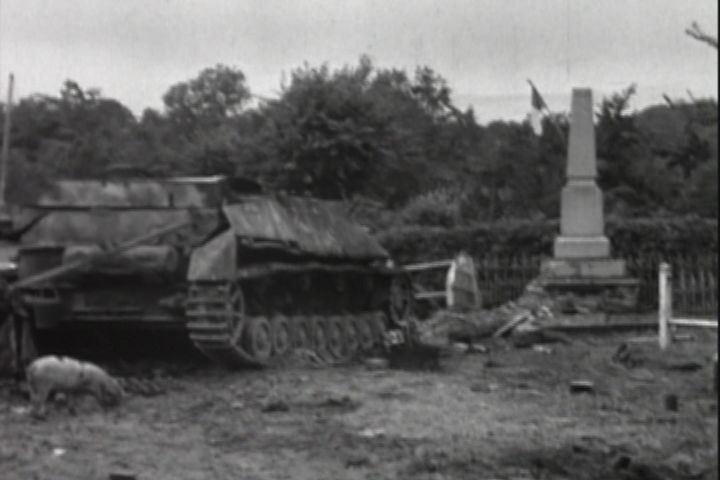
The sentiments of the tankers in 2nd Armored were echoed by other units, as seen in further comments from tank unit commanders interviewed by 12th Army Group:
7 December 1944
Subject: Visit to Ninth Army Area.
4. Tanks: Tank units [743rd and 747th Tank Battalions] have lost confidence in the 75mm tank gun as it cannot do the job it is called upon to do. Among tank requirements, the gun comes first. Tankers desperately desire a gun capable of knocking out enemy tanks and bunkers. Armor protection is secondary but is considered of far more importance than was formerly the case. All other considerations are minor and are considered as mere refinements and gadgetry. The M4A3E2 is very well liked and the two battalions prefer to be equipped 100% with this tank. The 76mm should be standard with this tank. Neither battalion now has any 76mm guns.
Headquarters 6th Armored Division 14 December 1944
b. M4E6 [i.e., wet stowage M4A3] Tank 1) The 76mm gun is desired. This is based on the fact that future targets in this theater will probably be steel or concrete. Against personnel, the coaxial machine gun is the best weapon.
B. All tanks of the M4 series. There is a definite lack of floatation and power compared with what we require to get effective results. Time and again a tank has been knocked out by direct fire because it could not negotiate a reasonable hill except at the very slowest speed. The great majority of tank losses can be attributed directly to being stuck in the mud or on a hill where they became easy targets for direct fire guns. Experience is indicated that direct fire guns have great difficulty in hitting moving tanks. Our whole tactical conception of the employment of tanks is based upon their maneuverability. When this is lost through lack of flotation or power, tank tactics disappears. …
1 February 1945 Subject: Visit to Armored Units XX and XII Corps.
2.d. The [778th] battalion has mostly M4A3 tanks. It has 9 76mm tanks and 4 M4A3E2 Assault Tanks. The M4A3E2 tanks are liked by the Bn for their armor protection…The battalion likes the 76mm over the 75mm especially in attacking concrete pill boxes. The Bn Commander would prefer to have a medium tank company instead of the present light company.
4.d. The [702nd] Battalion is up to strength on Medium Tanks and two under strength on light tanks…At the present time they have 5 76mm tanks and 5 M4A3E2. The latter tank is very popular due to its armor and new turret with vision cupola. They report that its mobility is satisfactory to their needs. The 76mm gun is preferred to the 75mm.
6.d. The [737th] Battalion has 39 medium tanks of which three were M4A3E2. This tank has been the most satisfactory for their type of combat but needs a heavier gun. Would prefer 90mm.
13 February 1945 Subject: Visit to Armored Units.
2. 6th Armored Division. c. Equipment: - Present tanks are entirely unsatisfactory, due to lack of a satisfactory gun and lack of flotation.
Again, a variety of views and opinions were expressed. Some are contradictory. But overall there is a clear pattern of dismay about US tanks. In particular it is clear that the tankers felt their guns were not adequate against German armor, while German guns were very capable against their armor. But note that it wasn't until December 1944 that the 9th Army units lost confidence in their 75mm guns.
It was in this setting that the M26 Pershing tank came in to the ETO. With its 90mm gun, 4-inch sloped armor, wide tracks and low profile it seemed to be the solution to the tankers’ major concerns. A new Ordnance report on the 90mm gun and its ammunition was prepared and issued along with the new T26E3s in January of 1945.
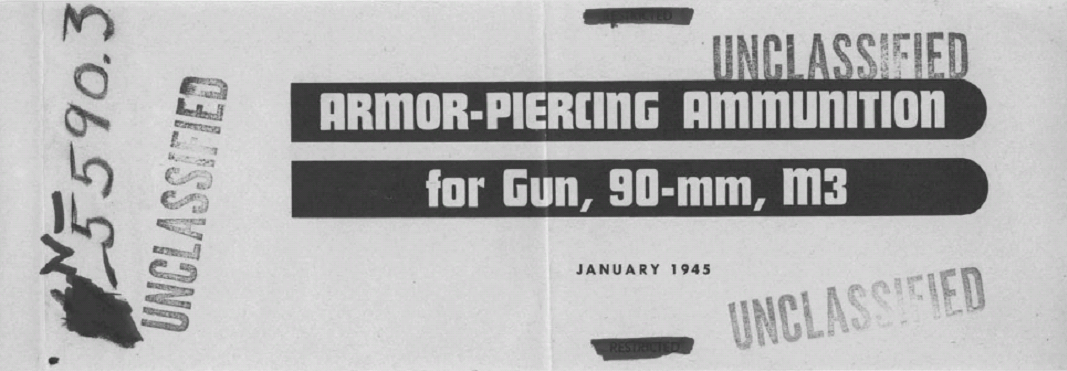
Ordnance published a new report on the ammunition for the 90mm gun in January 1945, co-incident with the arrival of the first T26E3 tanks.
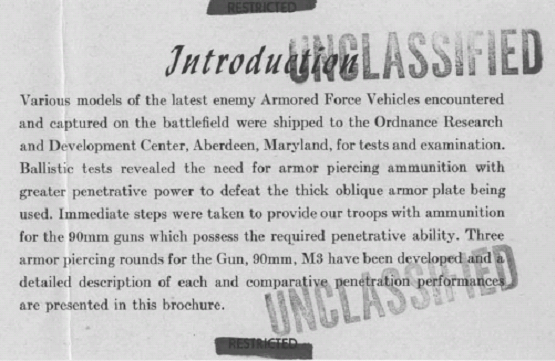
In this report Ordnance made it clear that they had gotten the message from the Isigny tests of the prior summer.
By this time Ordnance had given special attention to the metallurgy and design of penetrators, with an eye to the specific requirements for success against German heavy armor. The report included this description of the 90mm HVAP round (the emphasis, using font styles, has been presented as from original report):
Purpose: This is a special hyper-velocity, armor piercing round for attack of heavily armored vehicles. It gives greatly increased penetrative performance up to 2,000 yards range over the standard A.P.C.-T. Projectile, 90mm, M82. It is especially effective at shorter ranges. … This shot will penetrate all plates of the German Pz Kpfw V “Panther” and “King Tiger” Tanks. IT WILL DEFEAT THE GLACIS PLATE OF THE “PANTHER” AT RANGES UP TO 450 YARDS AND OF THE “KING TIGER” AT 100 YARDS RANGE. UP TO RANGES OF 800 YARDS THE SHOT WILL PENETRATE THE GUN MANTLET AND TURRET FRONT OF BOTH THE “PANTHER” AND “KING TIGER” TANKS.
The report included information on a new round for the 90mm gun, the T33, which reflected additional attention to the metallurgy needed to effectively penetrate Panther, and to design considerations needed for attacking the Panther at longer effective ranges:
Description: The 90mm Armor Piercing Shot T33 is issued as a fixed complete round for the Gun, 90mm, M3 mounted in Heavy Tan, T26E3 and Gun Motor Carriages, M36 and M36B1. The shot is a modification of the standard AP, M77 which has been reheat-treated and to which a ballistic windshield has been attached.
…
Purpose: This is the most effective shot for the defeat of high obliquity caliber thickness homogenous armor plate. The shot will defeat all plates of the German Pz Kpfw V “Panther” Tank except the gun mantlet. IT WILL PENETRATE THE GLACIS PLATE OF THE “PANTHER” TANK UP TO 1,100 YARDS RANGE.
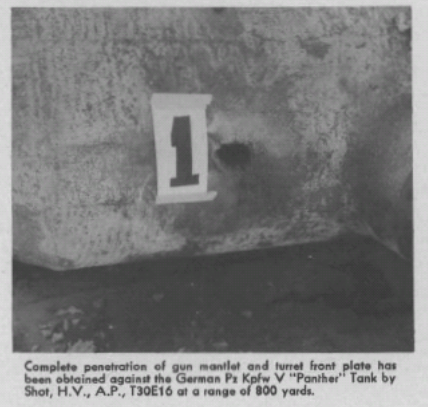
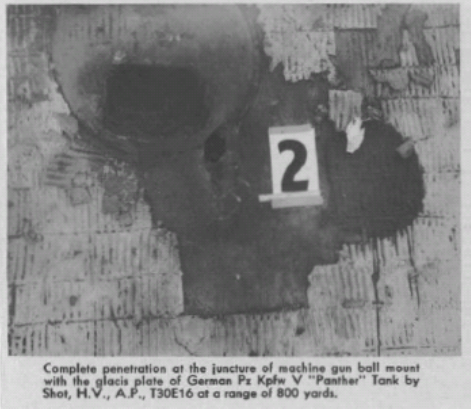
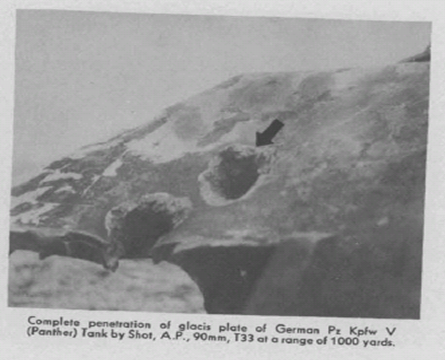
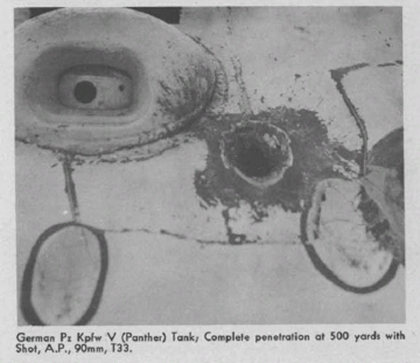
Extensive testing was done on Panther tanks that had been shipped to Aberdeen. As with typical Ordnance reports there were tables and charts of performance. But this report also included ample photographic evidence of the effectiveness of 90mm rounds on Panther tanks.
There would be no repeat of the prior summer’s surprises, when test results on US Ordnance plate did not match actual performance, due to the different characteristics of German armor.
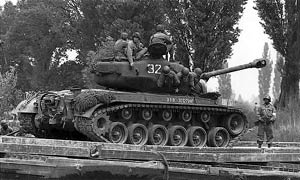
200 M26s were in ETO by the close of hostilities in 1945
Few M26s saw combat. The tank fighting qualities of the M26 were shown in small part by the actions of the first 20 T26E3s, but more so in the combat record of the M26 against Soviet-made T-34/85s in Korea six years later.
CONCLUSIONS
Perhaps the best summary of the attitudes of US tankers on their guns can be illustrated by the changing feedback given over time by the US 6th Armored Division. Revisiting the above-quoted surveys:
14 October 1944 Subject: Visit to Armored Units XII Corps.
3. Equipment. a. The 6th Armored Division has received no 76mm tanks and have no great desire for them…
Then:
14 December 1944 Subject: Operational Information on M-4 Series Tanks
Headquarters 6th Armored Division
1) The 76mm gun is desired. This is based on the fact that future targets in this theater will probably be steel or concrete. Against personnel, the coaxial machine gun is the best weapon.
Finally:
13 February 1945 Subject: Visit to Armored Units.
2. 6th Armored Division. c. Equipment: - Present tanks are entirely unsatisfactory, due to lack of a satisfactory gun …
This transition of views does not derive from any decline in the qualities of US guns, nor any improvement in German armor. Rather it is a reflection of the changing nature of the combat that 6th Armored was involved in. It is, in effect, a microcosm of the growing maturity of user feedback, as the US Army learned first-hand what tanks had to be able to do, while also gathering real-world data on what their own guns and their opponents’ armor were actually capable of.
The US Army was not alone in going through this learning curve. The Germans struggled in 1941, when they discovered that their tank guns were inadequate against the Soviet T-34. The Germans also discovered at that time that their standard AP rounds had poor metallurgical qualities. It took about a year, until mid- to late-1942, before the Germans had effected their solutions to these issues.
The British found out in 1941 that their 2pdr gun was not good enough against their German adversaries. They managed to respond on the firepower issue within a year, as the 6pdr began to replace the 2pdr, but it was not until almost two years later with the advent of the 17pdr that the British truly got the anti-tank firepower they wanted.
For the US Army’s perspective, the M4 was very well regarded by both British and US tankers in Tunisia in 1942 and 1943. When paired with the M10 tank destroyer (and later the M18), it appeared that the US had everything that was needed. And so they would have, if the panzers they faced in France in 1944 were the same panzers they had faced in Tunisia in 1943. But they weren’t.
US Army Ordnance had developed the basic tools. The Sherman had a 75mm gun in 1942. The 76mm gun was developed specifically to fit as an upgrade in the Sherman in 1942, and was available in 1943. The 90mm gun was developed in 1943, and was available for tanks in 1944.
But there was no consensus that this was the right path to follow. Ordnance’s own flawed testing lulled Army Ground Forces and the commanders in the European Theater of Operations into a false sense of security. It was not until the cold hard realities of combat in Normandy that a clear picture emerged on the needs for better guns to defeat the panzers. And even here AGF and ETO waffled on their feedback, demanding immediate solutions in the Summer, then asking only for more of the existing designs in the Fall, and finally screaming for immediate solutions again in the Winter/Spring. But as with any major industrial/technological undertaking, there are no immediate solutions. Fortunately, Ordnance continued their development efforts regardless of the changing user feedback, and so had effective solutions available within less than a year of the first hint of crisis.
The US Army responded better and faster than either the German or British armies. But alas, even with under-performing US tanks and guns, the Germans had been defeated before the US response to the Panther could make its way to the forefront.
So what of the whole debacle anyway? Would the outcome have been significantly different had the M4(76) been the standard American tank instead of the 75mm variant? Probably not. Neither would have been of great effectiveness against the German frontal armour, and as we’ve seen, when not facing the front of the cats, the 75mm seemed quite good enough. Would the outcome have been any different had HVAP ammunition been available for the 76mm guns from June 6th 1944? Again, I doubt it would have been enough to make a huge difference, as the ‘engagement range’ was such that it would only have helped a small amount of incidents. Of course, if you were the tank crew involved in that particular incident, you would have had a much different view of not having 76mm HVAP. 90mm guns were of practical utility but were being churned out pretty much as quickly as hulls could be found for them.
Really the US was a victim of nothing more than poor intelligence. They underestimated the enemy threat, and failed to prepare for it accordingly. It wasn’t that they couldn’t build tanks capable of winning the war with fewer losses, they chose chose not to since they honestly believed what they had was perfectly servicable and didn't warrant the issues with introducing the upgraded equipment. When informed otherwise by the Germans, they reacted with commendable speed whilst balancing out current operational requirements with future upgrades.
reminder to send to Mark
Tank info
Quite the article, thanks.
Thought you might be interested.
Because the Germans didn't use any at Kursk, and the Allies had no reports from the Russians as to the effectiveness of it, or what it would take to kill one.
Sure was. I've seen most of that material as far back as 1966, when I was going through Armor MOS training at Ft Knox. The WWII archives of the Patton Museum were made available to us, and a tour of the place was on our activities.
Having it here, saves me having to go to Ft Benning to find it. Thanks. Beat another training film any day....
Ping.
I’m glad I could be of service.
Any guesses as to whether Panthers would have made a difference at Kursk?
Only if Patton hadn't invaded Italy. Play ball!
Not what the article states:
“This report was based on information provided by the Soviets, as the Western allies had not yet met any Panthers in combat. The Soviets had captured or recovered several Panthers after the great armored battles of Kursk and their subsequent great advances across the Ukraine in the summer of 1943.”
Great article. As informative as any by Steve Zaloga.
Amazing find!
A great book on the subject is “Death Traps: The Survival of an American Armored Division in World War II,” by Belton Cooper. The author was in charge of recovering, cleaning out and repairing or dismantling damaged and destroyed tanks for Patton’s 3rd Armored Division.
One of the revalations in the book is that the US was ready to replace the Sherman before DDay. The US Army could have gone to war in France with the M26 Pershing, which was ready to start being produced as the US main battle tank in late 43. The major oppenent of the change was none other than Gen. George Patton, who falsely believed that a heavier tank with wider tracks would have to be slower on roads. He took the view that tanks would fill the roll of cavalry, running free behind enemy lines, and did not consider tank to tank fighting to be a major role. The Germans had other ideas, and the Amecans were forced into unequal battles that cost over 100% casualties in his tank crews over a period of 8 months.
Great article. Clarifies a lot of the organizational response to the panzer threat in the desperate days of 1944.
 good stuff...
good stuff...
So how exactly does the tribe go about wiping the Chieftan’s hatch.
Or does he wipe himself?
Part of the situation was Army Ground Forces doctrine. Tanks were vehicles of exploitation. They were to play the role of horse cavalry. Tank to tank warfare was to be the domain for the tank destroyer force. The Pershing was a not ready for early 1944 manufacture. Consideration was given to replacing the Sherman with the T 20 series. These tanks had the lower silhouette of the Pershing but carried the same armament as the 75mm and 76mm Shermans. The Shermans proved ideal for the open warfare of July, Aug and early Sept 44, and combined with the Jabos of the 9th AF their results would not have been improved upon had they been replaced with half as many Pershings.It was true that in tank to tank battles US tankers were ata disadvantage, but in infantry combat US troops were also at disadvantage given the quality and numbers of the MG42 which all but negated any advantage of the Garand over the Mauser. What really gave US forces a solid advantage was the superiority of its artillery. In terms of its quality, numbers and time on target doctrine it was the King of the battlefield from the earliest days at Kasserine to the very end.
Disclaimer: Opinions posted on Free Republic are those of the individual posters and do not necessarily represent the opinion of Free Republic or its management. All materials posted herein are protected by copyright law and the exemption for fair use of copyrighted works.